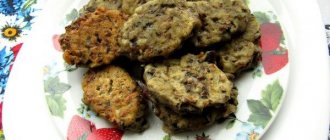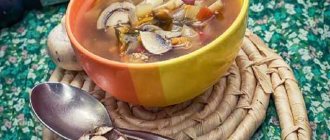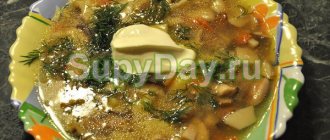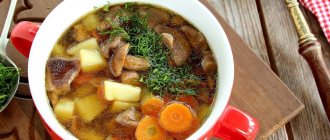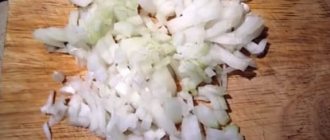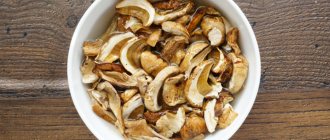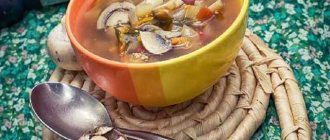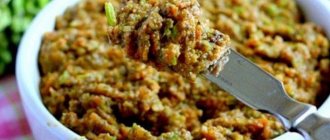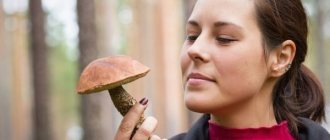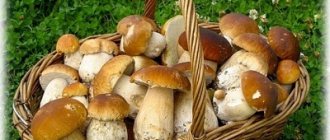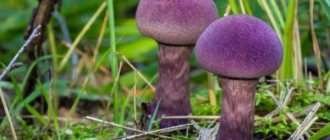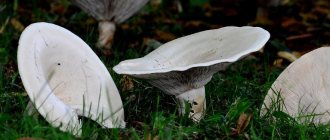Mushrooms grow all over the earth. All of them are divided into edible and poisonous. The former are rich in protein and minerals, the latter are dangerous for humans. Experienced mushroom pickers can easily distinguish one mushroom from another, but beginners should not rush and cut off just anything. You need to know that most edible mushrooms have “false doubles”, which are often unsuitable for consumption. From this variety, we have selected ten of the most delicious and most famous mushrooms. Get it! Before you go into the forest for a “silent hunt”, you need to find out the varieties, name, description and look at photos of edible mushrooms.
TOP 10 edible mushrooms description and photo
Our top ten edible mushrooms rightfully include:
- Porcini;
- Saffron milk caps;
- Boletuses;
- Boletus mushrooms;
- Butter;
- Chanterelles;
- Honey mushrooms;
- Champignon;
- Milk mushrooms
- Truffles.
Let's start from the end of our list, without forgetting the photos of course! Go.
Morel (Morchella)
Appears in early spring, after the snow melts. It's not easy to find. The most common habitats: wet ravines, deciduous forests, and other places with soil rich in nutrition. It should not be confused with another early mushroom, the string, which is considered conditionally edible.
In Russia, this amazing mushroom, shaped like a shriveled brain or a sponge, is practically not eaten, but in European countries it is considered a delicacy and costs about $560 per kilogram. When drying, this price can increase many times.
Tenth place. Truffles
Truffle (lat. Tuber) is the most expensive mushroom in the world, a rare and tasty delicacy with unique taste and a strong specific aroma. The mushroom received its name due to the similarity of its fruiting body to potato tubers or cones (the Latin phrase terrae tuber corresponds to the concept of earthen cones). The truffle mushroom belongs to the department Ascomycetes, subdivision Pezizomycotina, class Pezizomyceae, order Pezizoceae, family Truffleaceae, genus truffle. In most cases, the truffle mushroom is slightly larger in size than a nut, but some specimens can be larger than a large potato tuber and weigh more than 1 kilogram. The truffle itself is similar to a potato.
Photo of truffle
The outer layer (peridium) covering the mushroom can have a smooth surface or is cut with numerous cracks, and is also covered with characteristic multifaceted warts. The cross section of the mushroom has a clearly defined marble texture. It is formed by alternating light “internal veins” and “external veins” of a darker shade, on which spore bags of various shapes are located. The color of the truffle pulp depends on the species: it can be white, black, chocolate, gray. Truffles are also found in Russia – on the Black Sea coast of the Caucasus. The tuberous, fleshy fruiting bodies of truffles are found underground and are searched for with the help of specially trained dogs or pigs.
Classification of mushrooms in the USSR
Previously, during the Soviet era, they used the classification of mushrooms proposed by B.P. Vasilkov. It is clear and simple, so it can be used, although it is considered outdated.
Classification of mushrooms
| Category | Description | Names of mushrooms |
| First | The best mushrooms in terms of both taste and nutritional value. | Porcini mushroom, real milk mushroom, saffron milk caps, chanterelle. |
| Second | These mushrooms have a pleasant taste, but are not as nutritious. | Boletus, champignons, white russula, oak, milk mushrooms (oak, golden yellow), boletus, boletus (common, summer). |
| Third | They have average taste and nutritional value. | Milk mushrooms (black, aspen, poplar), milk mushrooms, moss mushrooms, real honey mushrooms, russula, morels. |
| Fourth | Bad taste, no nutritional value. Collecting them is not recommended. | Oyster mushrooms, dung beetles, talker mushrooms, some types of milk mushrooms (felt milk mushrooms, violin mushrooms, pepper mushrooms), bigheads, puffballs, hedgehog mushrooms, meadow and summer honey mushrooms, row mushrooms, variegated umbrella mushroom, etc. |
Ninth place. Aspen milk mushroom
Aspen milkweed (lat. Lactarius controversus) is a mushroom of the genus Milky (lat. Lactarius) of the Russulaceae family (lat. Russulaceae). The cap is 6-30 cm in size, very fleshy and dense, flat-convex and slightly depressed in the center, in young mushrooms with slightly fluffy edges curved down. The edges then straighten out and often become wavy. The skin is white or mottled with pink spots, covered with fine fluff and quite sticky in wet weather. The pulp is whitish, dense and brittle, with a slight fruity odor and a rather pungent taste. It produces abundant white milky juice that does not change in the air and is bitter. The leg is 3-8 cm in height, strong, low, very dense and sometimes eccentric, often narrowed at the base, white or pinkish. The plates are frequent, not wide, sometimes bifurcated and descending along the stalk, cream or light pink. Spore powder is pinkish, Spores are 7 × 5 µm, almost round, folded, veined, amyloid.
Photo of fish - aspen milk mushroom
The color of the cap is white or with pink and lilac zones, often concentric. The plates are whitish at first, then they turn pink and finally become light orange. Ecology and distribution The aspen milkweed forms mycorrhiza with willow, aspen and poplar. It grows in damp aspen and poplar forests, is quite rare, and usually bears fruit in small groups. The aspen milkweed is common in the warmer parts of the temperate climate zone; in Russia it is found mainly in the Lower Volga region. Season July-October. A conditionally edible mushroom, it is used mainly in salted form, less often fried or boiled in main courses.
Eighth place. Champignon
Champignons are mushrooms that belong to the class Agaricomycetes, order Agariaceae, family Champignonaceae, genus champignon (lat. Agaricus). Champignon - description and characteristics: Champignon caps have a massive appearance. The small mushroom has a rounded cap, but as it grows it straightens and becomes flatter, reaching a diameter of 10 cm. Depending on the species, the color of the cap can be either white or brown, sometimes even brown. Its surface can be not only smooth, but also with hard scales. The spore plates change color over time from white to almost black. The leg of champignons is white, up to 10 cm high and up to 4 cm thick. It is often dense, but rarely hollow or loose. {reklama}Young mushrooms have a white film at the bottom of the cap, and when the mushroom grows, this dense film breaks and moves to the stem, forming a “ring”.
Photo of champignon mushroom
The flesh of the mushroom is often white, but when exposed to air it often changes color, acquiring a red or yellow tint. The calorie content of boiled champignon is 37 kcal per 100 grams of boiled mushroom, and canned champignon is 12 kcal per 100 grams of product. Champignon has the following beneficial and medicinal properties:
- Increased appetite;
- Improved digestion;
- Improving metabolic processes;
- Removing cholesterol from the body;
- Prevention of thrombosis and heart attack;
- Prevention of atherosclerotic changes;
- Antioxidant effect;
- Slowing down the aging process;
- Positive effect on blood vessels and heart;
- Bactericidal and antiviral effect;
- Reducing inflammation;
- Bronchodilator and expectorant effects;
- Improving brain function and memory;
- Removing radionuclides and toxins from the body.
Reishi (Ganoderma, Mannentake)
In China it is called the “mushroom of immortality” or “ling zhi”, and in the Land of the Rising Sun, Japan, it is called the “mushroom of spiritual power”, “reishi”. Its scientific name is lacquered tinder fungus.
Appears at the base of sick or dying trees. It has a flat, ridged cap of a brownish-violet or red hue. It is highly valued for its medicinal properties. Used in the treatment of viral and oncological diseases, helps improve immunity. The price for this mushroom starts from 2,000 rubles.
Seventh place. Honey mushrooms
The honey fungus has a flexible, thin, sometimes quite long leg (can reach 12-15 cm), the color of which varies from light honey to dark brown depending on the age and location of the honey mushroom. The leg of many mushrooms (not all) is “dressed up” in a ring-skirt, and it is crowned with an elegant lamellar cap, usually rounded downwards. In a young mushroom it is hemispherical in shape, covered with small scales, but as it “matures” it takes on an umbrella shape and becomes smooth. The shade of the honey mushroom cap varies - from cream or yellowish to reddish tones. Most often, honey mushrooms grow in large groups on old stumps, not far from weakened trees in wooded areas. Honey mushrooms can be found everywhere - both in the Northern Hemisphere and in the subtropics. This mushroom only dislikes harsh areas of permafrost.
Photo - honey mushrooms
Benefits of honey mushrooms - Due to the high content of magnesium, iron, zinc and copper in mushrooms, honey mushrooms have a positive effect on hematopoietic processes, so they are recommended to be taken for anemia. Just 100 g of these mushrooms is enough, and you can fill your body with the daily norm of microelements necessary to maintain hemoglobin. Numerous types of honey mushrooms differ significantly in their vitamin composition. While some types of these mushrooms are rich in retinol, which is useful for strengthening hair, promoting youthful skin and healthy eyes, others are endowed with large amounts of vitamin E and C, which have a beneficial effect on the immune and hormonal systems. Honey mushrooms are also considered natural antiseptics, as they boast anti-cancer and antimicrobial properties. In their strength they can be compared to antibiotics or garlic, so it is useful to take them if you have E. coli or Staphylococcus aureus in your body.
Sixth place. Chanterelles
Chanterelles are wild mushrooms that resemble an inverted umbrella. Their caps are orange or yellow in color, and their legs are dense and light-colored. Chanterelles have a sour smell and are almost never wormy. They can be found in forest belts with a temperate climate among grass, under pine needles or moss. They form entire groups and often appear after rains and thunderstorms. Chanterelles have found their use in cooking and medicine; they are used as a cure for many known pathologies. Chanterelles are easy to find in the forest and almost impossible to confuse with other mushrooms.
Photos of chanterelles
However, it is important to be able to distinguish them from their doubles, assemble and prepare them correctly, and also remember the contraindications and possible health hazards of this product. If we talk about the benefits of these mushrooms. Chanterelles prevent the development of cardiovascular diseases and improve immunity. 200 g of this product replenishes the daily need for ascorbic acid, sulfur, magnesium and iron in women.
To distinguish a chanterelle from its counterpart, you need to remember the following features of the edible mushroom:
- If you press on a chanterelle, its flesh will change its color; in a false mushroom, it will remain the same color.
- Edible mushrooms have a thicker stem, while the false chanterelle has a thinner stem.
- The edible chanterelle has ragged edges, while the false chanterelle has a rounded shape.
- The inedible mushroom has an unpleasant odor and bad taste. It is usually smaller in size.
- Edible mushrooms always grow in groups.
Oyster mushroom
Oyster mushroom or oyster mushroom, as our Western brothers are used to calling it, can be bought in any store today. However, in southeast Asia, Canada and the USA, such a mushroom is difficult to obtain and is considered a delicacy.
In Asian regions, oyster mushrooms are used to prepare sauces, snacks, and dumpling fillings. In composition, oyster mushroom is close to meat, the taste of the mushroom is pleasant, vaguely reminiscent of notes of anise or bread. Mushrooms are even suitable for cooking borscht.
Fifth place. Butter
Butterflies are small and medium-sized mushrooms, some varieties are similar to moss mushrooms. The cap of young mushrooms has a hemispherical, sometimes conical shape. As it grows, it straightens and, as a rule, takes on a shape similar to a pillow. The largest diameter of the cap is 15 cm. A feature of butter mushrooms that distinguishes them from other mushrooms is the thin film-like skin covering the cap: sticky and shiny. It can be slimy, constantly or only during wet weather, and in some species it is slightly velvety, subsequently cracking into small scales. The skin is usually easy to separate from the pulp. Its color varies from yellow, ocher tones to brown-chocolate and brown, sometimes with spots and color transitions. The color of the cap depends not only on the type of oiler, but also on the light and the type of forest in which it grows. The leg of the butterfish is cylindrical in shape. Its average dimensions are: diameter from 1 to 3.5 cm and height from 4 to 10 cm. The color is whitish with a dark bottom or matches the color of the cap. It happens that a whitish liquid is released from the pores and solidifies in droplets on the stem, while its surface becomes granular.
Photos of oil
Butterflies (lat. Suillus) are mushrooms that belong to the department Basidiomycetes, the class Agaricomycetes, the order Boletaceae, the oilcan family, the genus of oilers. Butter mushrooms get their name from the shiny, sticky skin that covers the cap, making it appear as if the top of the mushroom is smeared with oil. In different countries, the name of this mushroom is associated precisely with the “buttery” appearance of its cap: in Belarus – Maslyuk, in Ukraine – Maslyuk, in the Czech Republic – Maslyak, in Germany – Buterpilz (butter mushroom), in England – “slippery Jack”
Matsutake (Tricholoma matsutake)
A very expensive mushroom, valued for its unusual taste and aroma, reminiscent of pine, for which in Asia it is sometimes called “pine mushroom.” It has an umbrella-shaped brown cap, white, elastic flesh with a spicy cinnamon aroma. It grows on poor, infertile soils, under the cover of dense trees (fir, pine).
Despite the abundant fruiting, it is very difficult to find it, since it is practically invisible under the fallen leaves. Because of this, the price of this unique natural product is quite high: about 2,000 US dollars per kilogram fresh.
Fourth place. boletus
Boletus is an edible mushroom of the 2nd category. It has a dull brown, cushion-shaped cap and a white thin stalk (up to 17 cm) with brownish scales. Grows in deciduous forests near birch trees. (carlfbagge) Boletus is an excellent mushroom. You can fry, boil, dry and store for the winter. The boletus mushroom has a calm taste and aroma, it is very easy to recognize in the forest, and is easy to collect and cook. A few simple recommendations from Culinary Eden will help you prepare a delicious lunch or dinner on the occasion of finding boletus mushrooms.
Photo of birch grass
The boletus mushroom grows in deciduous forests, mainly in birch forests. Mushrooms are found in parks and young growths of birch trees near forests; they love the edges of clearings, overgrown old paths in light mixed forests and along the edges of ravines. The boletus appears at the end of May at the same time as boletus and white boletus, or a little earlier. The boletus loves warmth and grows where the sun warms up the soil with mycelium well. The boletus has four varieties:
- common boletus
- black boletus
- tundra boletus
- marsh, white boletus
- pinkish, oxidizing boletus
- gray boletus, hornbeam
- tough boletus
- checkerboard, or blackening boletus
- ash-gray boletus
- colorful boletus
About 9 species are found on the territory of Russia, among which the most common are the common boletus and the hornbeam. People also have other nicknames: obabok, birch tree, grandma, etc.
Third place. Boletus
The real milk mushroom is an edible mushroom of the 1st category. It has a white mucous cap (up to 20 cm) funnel-shaped with pubescent edges rolled inward and a white or yellowish stalk (up to 7 cm). Grows in deciduous and mixed forests. Boletus, also known as aspen or redhead, is the combined name for various species of mushrooms of the genus Leccinum (lat. Leccinum) or Obabok. The mushroom got its name due to the close connection of its mycelium with aspen, because it is in aspen forests that mushrooms are most often found. And also because of the obvious similarity of the color of the caps with the autumn color of aspen foliage.
What does a boletus look like?
All types of boletuses are characterized by a brightly colored cap, a stocky leg and a dense structure of the fruiting body. The diameter of the cap, depending on the species, can range from 5 to 20 (sometimes 30) cm. At a young age, almost all types of redheads are distinguished by a hemispherical shape of the cap, which tightly compresses the top of the stem. The cap of a young red mushroom looks like a thimble placed on a finger. As the boletus grows, the cap acquires a convex, cushion-shaped shape; in completely overgrown mushrooms, it becomes noticeably flattened. The skin covering the cap is usually dry, sometimes velvety or felty; in some species it hangs from the edge of the cap and in most mushrooms is not removed. The tall (up to 22 cm) leg of the boletus has a distinctive, club-shaped shape with a pronounced thickening at the very bottom. The surface of the leg is covered with small scales, often brown or black. Boletus leg with scales. The porous layer under the cap, characteristic of all members of the boletaceae family, has a thickness of 1 to 3 cm and can be pure white, greyish, yellow or brown.
Maitake (Grifola curly)
This mushroom is called differently: Maitake , Grifola curly , ram , dancing mushroom . It is considered a rare species and is listed in the Red Book of Russia.
It can be found from the end of June to the end of September; it grows in deciduous forests, most often found at the base of old oaks, and occasionally - maples, beeches and chestnuts. It grows very quickly, fruiting bodies reach a diameter of up to 80 cm and weigh up to 10 kg. They consist of thin caps with a diameter of 0.5 to 5 cm.
It is edible and has a pleasant nutty taste. In addition, the mushroom is very useful, has bactericidal properties, and eating it helps cope with inflammation and pain. 50 g of this mushroom costs about 400 rubles, i.e. 1 kg about 8 thousand rubles .
Second place. The saffron milk cap is real
Real camelina is an edible mushroom of the 1st category. It has an orange or light red funnel-shaped cap with straightening edges and a stem of the same color (up to 7 cm). Grows in coniferous forests. The true saffron milk cap belongs to the Russula family, the genus Milky. The Latin name of the mushroom is Lactarius deliciosus. Description of the real saffron milk cap - The diameter of the cap ranges from 5 to 15 centimeters. The shape of the cap is flat-convex, but over time it becomes wide funnel-shaped. White stripes run around the circumference of the cap. The edges are slightly curled, later becoming straight. The color of the cap is orange-red. The length of the camelina leg reaches 3-7 centimeters, and the diameter varies from 1.5 to 2.5 centimeters. The leg is brittle, its shape is cylindrical, and it is hollow inside. The hat and leg are the same color. If you touch the leg, it turns green. The pulp is orange, brittle, and turns green when broken. The milky juice is plentiful, not hot, orange-red, and turns green in the air. The smell of the pulp is pleasant - fruity. The plates are adherent, slightly descending, their width is 0.5-0.9 centimeters. The color of the leg is orange-yellow; when touched it turns green. The plates are notched, often fragile. The spores are warty, oval, and may be light yellow or colorless. The spore powder is yellowish. Places where real saffron milk caps grow - Real saffron milk caps are widespread in the European part of the country, in Siberia, the Urals and the Far East.
Rizhik photo
Harvest time is June-October. They are collected before the first frost. Real saffron milk caps grow in coniferous and deciduous forests. They can be found mainly in young forests, forest edges and clearings. They hide among the grass, so collecting them is not easy, since you have to look for them; even bright colors among dense vegetation do not help very well. You can stand nearby and not notice them; to find the saffron milk cap, you need to part the grass. But the plus is that if you find one mushroom, you can pick a basket, since they never grow alone, but in whole families. Edibility of saffron milk caps - Real saffron milk caps are great for pickling and pickling, but they are not suitable for drying. The taste of real camelina is piquant, pleasant, and the aroma is fruity. In terms of taste, this edible mushroom belongs to the 1st taste category, that is, it is very tasty. The chemical composition of this mushroom includes fats, proteins, carbohydrates, in addition, there is a biological substance fungin, which stimulates gastric secretion. In addition, saffron milk caps are low in calories.
Yarsagumba (Cordyceps sinensis)
Yarsagumba or Chinese Cordyceps costs from 50 to 120 thousand dollars per kg. But this is not an accident, because... collecting so many mushrooms is not so easy. It grows in the mountains of Tibet, at an altitude of 4 km and above.
It is a parasitic fungus that grows in the bodies of caterpillars of the butterfly Hepialus armoricanus, eating its living host. The caterpillars gradually die, and a mushroom sprouts from its body. It is collected by residents of Nepal and India.
It is used in Tibetan medicine and has healing properties. It is said to act as a strong aphrodisiac.
7 1
